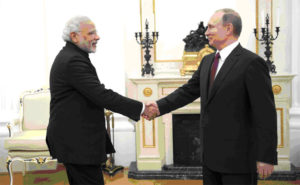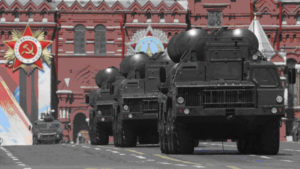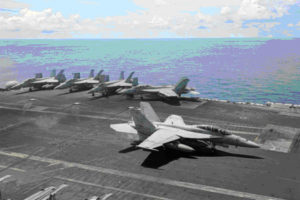Buying Arms From Russia May Help India Make Peace
By Saurabh Joshi
16 Dec 2021
India’s defence purchases from Russia and the US have in recent years worked to its advantage in different ways.

Russia’s President Vladimir Putin visited New Delhi last week, only his second visit overseas this year
New Delhi: Last week India signed a pact with Russia to produce more than 600,000 Kalashnikov AK203 rifles in the northern Indian state of Uttar Pradesh. The $675m deal may be relatively insignificant in dollar terms compared to the standard of complex missiles and submarines that are typical of defence deals. But it is the latest iteration of the strategic value that the country gets with its defence orders, say analysts.
The deal was signed during Russian President Vladimir Putin’s visit to New Delhi for the 21st India-Russia Annual Summit, only the second time he went abroad this year, after his meeting with US President Joe Biden in Geneva.
That Russia and India also agreed to renew their ten-year military cooperation agreement at the time is a sign of the strategic balancing act Delhi is striking between Russia and the US while keeping China’s growing influence in check by keeping Moscow close to Delhi.
India’s defence purchases from Russia and the US serve different purposes, said Angad Singh, project coordinator at New Delhi think-tank Observer Research Foundation’s Strategic Studies Programme.
“Fundamentally all defence purchases are aimed at maintaining the balance of power against adversaries, but I think India understands that defence ties with Russia and the US are serving different purposes beyond basic capability-based arithmetic,” Singh told Al Jazeera. “The US is an Indo-Pacific power with skin in the game against China. Russia is able to share sensitive strategic technologies. Both work to India’s advantage in different ways.”
Behind The Curtains
Sure enough, both Russia and the US operated from behind the curtains as border tensions with China moved towards today’s uneasy peace.
The US military, for instance, held joint military exercises hosted by India that coincided with military commander-level talks between the Indian Army and the Chinese PLA. Russia, more directly, facilitated talks between Indian and Chinese foreign ministers that have led to the shaky quiet on the border which has stemmed further bloodshed since June 2020.
“A country like Russia with ties in Delhi and Beijing is well placed to facilitate talks,” said ORF’s Singh. “But equally, between Russia straddling the fence and the kind of military access and capabilities provided by the US — for example during the Doklam crisis in 2017 — I think policymakers in Delhi know the US is no less important.”

Russia has sold the S-400 air defence system to both China and India [File: Sergei Karpukhin/Reuters]
Russia sells defence equipment to China like the S-400 air defence system that it has also sold to India.
At the same time, India leans on Russia for some of its more complex defence requirements like nuclear-powered submarines – New Delhi has leased three from Moscow in the past and the latter is now helping it with its indigenous nuclear-powered submarine programme.
“It’s a matter of compulsion for India’s armed forces that if we want high-tech equipment then we also need to buy low-tech equipment, as well. In that sense India is very dependent on Russia and this dependency is a powerful factor in bilateral relations,” said Admiral Arun Prakash (Retired), former Indian navy chief. Moreover, he added, “it’s undeniable that no one else will offer such items or technology” as a nuclear submarine or assistance with nuclear submarine propulsion.
This cooperation is rooted in history. After the fall of the USSR, erstwhile Soviet defence companies were on the verge of collapse and it was Indian orders to overhaul the former Admiral Gorshkov aircraft carrier and financing to develop the Sukhoi-30MKI and MiG-29K aircraft that breathed new life into the Russian defence industry, said Admiral Prakash. Both those aircraft have been key for the Indian forces ever since.
“It’s essential to bear in mind that the suppliers of military hardware benefit as much from the deals, as the recipient,” he said, adding, “India needs new weaponry and the need translates into strategic relationships. It’s not very different with US defence companies, though less so.”
But apart from business, there is a more strategic imperative here as well for India and Russia to be “clinging” to each other to slow, if not altogether halt, what they see as “the other’s strategic drift”, Arzan Tarapore, South Asia Research Scholar at Stanford University, told Al Jazeera.
New Delhi is keen to ensure that Russia does not slip further into China’s orbit just as Moscow is no doubt concerned by India’s steadily deepening alignment with the US, he said. Such arms deals, he noted, offer a way for India and Russia to maintain a diversified portfolio of security partners, and keep each other from drifting too far into US and China-dominated camps.
Diversification
The US appears to have less of a choice in this respect and so far, at least, it has not activated the Countering America’s Adversaries Through Sanctions Act (CAATSA) against India, a law that empowers it to impose sanctions against officials and countries doing, among other things, big-ticket defence deals with Russia.
The US kicked out NATO member Turkey from the fifth-generation F-35 fighter programme, denying it access to the advanced next-generation aircraft and forcing it to ask for older aircraft. In addition, the US sanctioned it last year under the same law for purchasing the S-400 system from Russia. This is the same system that cost India more than $5bn.
Despite its historical dependency on Russia for its defence arsenal, India has over the years started diversifying its purchases and has signed deals with the US worth at least $16bn since 2008, around the time that the two countries signed a civilian nuclear deal, money that might otherwise have gone to Russia.

India is contemplating buying Boeing’s F/A-18 Super Hornet carrier-borne fighter aircraft (pictured)
Arms deals and the competition for them have played a role in the balance that India tries to maintain with Russia and the United States and its allies, but this has become more urgent since the skirmish with the Chinese People’s Liberation Army (PLA) on India’s northern borders that has been simmering since the summer of 2020.
“The impact of defence sales transcends far beyond the financial transactional aspect and the acquisition of new hardware,” Admiral Prakash told Al Jazeera.
The Indian navy is now scoping Boeing’s F/A-18 Super Hornet carrier-borne fighter aircraft, among others, and should it go ahead with that purchase, it would become only the third operator in the Indo-Pacific region after the US Navy and the Royal Australian Air Force.
The three already operate a Boeing maritime patrol aircraft and a Lockheed Martin helicopter. They, along with Japan which operates a different version of the helicopter, have also in the last couple of years come together in regular naval exercises–the so-called Exercise Malabar which is a military manifestation of the four-nation Quad–which have served to greatly irritate China.
The common equipment and platforms that the four nations use–thanks to a level of trust in bilateral relationships–make things a lot easier when sailing under different flags for the same mission.
Such interoperability can also lead to further joint activities beyond exercises between the respective militaries in the region, “if the national leadership recognises a congruence of interests”, says Admiral Prakash.
The interest of India here is to prevent further challenges to its security from China, whether it be through its defence trade and cooperation with Russia or the US.
Russia’s strategic value remains far above that of a consignment of rifles for India, especially with reports now of a potential trilateral summit proposed by Putin and Chinese President Xi Jinping.
And while much of the Washington establishment would “gnash their teeth” watching this continued India-Russia cooperation, they should recognize it is better than the alternative, for American interests, said Stanford’s Tarapore, adding, “Russia remains a nettlesome strategic challenge, but it would be tougher if it became beholden to China.”
Courtesy: Al Jazeera

